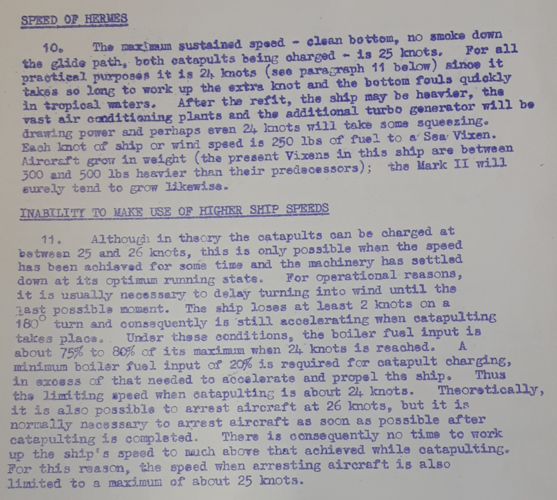The F-8C SAC gives a max take-off weight from catapult as 27,938 lb (same as land, and is with full internal fuel & ammo and 2 AIM-9s - the -C had no underwing pylons).
It gives "power-off" stall speed of 137.5 knots at that weight.
Stall speed at arrested landing weight of 22,000 lb is listed as 113.7 knots "power off", 110 knots "with approach power", so the take-off stall speed with power on should be ~134 knots.
So it looks like a minimum "catapult end combined speed" of 140 knots (preferably 145 knots) is required.
The 103' BS4 gives an end speed for a 30,000 lb aircraft of 101 knots and 78 knots for a 40,000 lb aircraft, so 28,000 lb should get around 108 knots from the catapult alone.
Add in 20 knots ship speed (Hermes' listed max is 28 knots, but the design speed is without diverting steam to the catapults) and we are at 128 knots... 12 knots short.
So we need 12+ knots wind speed to get to safe minimum take-off speed.
The 145' BS4A gives 120 knots for a 30,000 lb aircraft, so it should throw our F-8C at ~130 knots, added with 20 knots ship speed easily gives us safe minimum take-off speed in 0-wind conditions.
The 130' BS4C of Centaur (which should fit on Hermes since on Centaur both BS4C catapults extended past the lift) gives an end speed for a 30,000 lb aircraft of 110 knots, meaning Centaur could launch a F-8C with 3+ knots of wind.
HOWEVER
Looking at the SACs for the F-8E and the F-8J (modernized -E with wing of the F-8E(FN) with BLC) the power-off stall speed (thus no BLC) for their MTOW of 35,000 lb (using the pair of underwing pylons) is 154 (F-8J) to 158 (F-8E) knots!
I would expect a 2-seat F-8 with a Spey instead of a J57 to come out about the same weights as the F-8E (considering the lighter engine would counter the added weight of the new radar, second seat & crewman, etc).
It looks like stall speeds drop some 10 knots with BLC on, but that is still an increase of 5-10 knots in take-off stall speed, so that becomes an issue for the BS4 catapult.
"Crusaderizing" Hermes does require replacing the BS4 with a BS4C to allow launches from both catapults.
This would see Hermes (and Centaur) capable of launching 35,000 lb weight F-8(RN)s from their BS4Cs with ~15+ knots wind speed, and from Hermes' BS4A with ~5+ knots wind (less wind needed for less-than-max take-off weights - stall speed drops by 5 knots at 33,767 lb and another 7 at 31,800 lb with 4x AIM-9s and nothing on the underwing pylons ).
Looking at the arresting gear of Hermes, she completed with 5-wire 35,000 lb system which was increased to 45,000 lb in her 1964-66 refit (along with getting the BS4A) - so this should be more than adequate.
Centaur got a 6-wire 35,000 lb system in 1960 along with her catapults... so she could operate Crusaders as well, although they would have little "bring-back" weight available.
Needless to say, the slightly faster trio of Eagle (from 1964 on), Ark Royal (BS4As from 1960, and Victorious (BS4As from 1958) could operate our proposed Royal Crusader

as soon as they could be delivered, with Centaur available as well! Poor Hermes would get them by July 1966 as well!
As for aircraft lifts - Eagle & Ark Royal had 54' x 33' aft lifts & 54' x 45' fore lifts, Victorious had a 54' x 34' aft and 58' x 40' fore lift, both of Centaur's lifts were 54' x 44', and Hermes had a 54' x 44' aft lift and a 54' x 45' side lift.
The F-8E was 54' 6' long (all others were 54' 3" long) and 35' 8" wingspan (22' 6" with wings folded), so even with a larger radome it would easily fit on all the lifts if set slightly diagonally (or straight if the radome folds to one side).
All of these lifts had a weight capacity of 40,000 lb save Centaur's fore lift, which was limited to 37,000 lb.
OOPS... did I just clear the F-8(RN) for 5 RN carriers?




